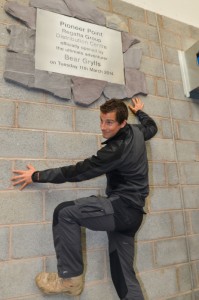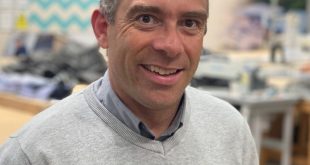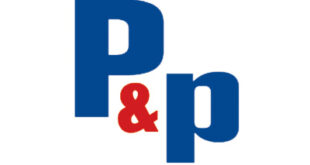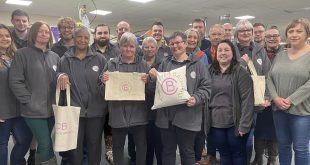 Regatta is unusual in the printwear and promotion industry as it was born and built outside of the sector, and almost stumbled upon what has become a major plank of its business.
Regatta is unusual in the printwear and promotion industry as it was born and built outside of the sector, and almost stumbled upon what has become a major plank of its business.
There are two strands to that tale: firstly, the company had been supplying orders from distributor BTC since the mid 90s, and when those orders started to climb, Regatta quickly became interested in the sector.
Secondly, the company also had a long-standing presence in workwear dating back to the previous generation of Regatta’s owners, the Black family.
This had begun with Risol, an import trading company that bought and sold existing products, typically donkey jackets and workbags, which then became involved in outdoor clothing in the late 70s/early 80s, launching the Regatta brand in 1981.
The inspiration behind that switch came from current chairman Lionel Black, who used to manufacture quality raincoats in Manchester for blue chip customers like Marks & Spencer, building up a raft of experience for the future growth of Regatta.
As the company grew it also made a pioneering move into production in Asia. Anthony Haber, director of Regatta Professional – the group brand that caters for the printwear, corporate and workwear sectors – explained: “The infrastructure in Asia then was pretty rickety, but there was a job to be done: to ensure that we could make products to a high standard half way round the world.
“The result was high quality outdoor clothing that did a good job and was far more affordable than what had been available before.”
However, industry folklore suggests that the now famous ‘Regatta’ branding – implying a ‘yottie’ and all-weathers connection – may have been an accident.
“The story goes that a shipment of jackets came in with Regatta printed on them, even though we hadn’t asked for it,” said Anthony. “But they were distributed and customers came back begging for more – ‘we like these, can we have some more Regatta jackets?’ ”
Another boost came with fleece, he added: “We were the first big brand to introduce fleece to the mass market. It was about great value and quality.
“Regatta wanted to create nicely designed garments that people could afford to wear for leisure generally. You didn’t have to be halfway up a mountain – you could want one for walking the dog, say.”
While this revolution in outdoors was occurring, the company workwear business was left to mark time until 1999, when Regatta realised the potential there too: “The donkey jacket could get very heavy and smelly when wet; the new technology opened up a world of opportunity for us,” said Anthony
But major differences were soon found in supplying outside the retail sector, said Anthony: “The product lifecycle of a retail garment usually lasts just six months or one season.
“However, the lifecycle of a Regatta Professional garment is typically 4-5 years or even 10, and never less than two.
“Firstly, if Professional customers find a product they like or does the job, they want to buy it again and again. Secondly, changing a product is time consuming and costly for everybody. Thirdly, with corporate uniform and identity, the end user company wants to be able to keep buying the product in the future so they can kit out new people and cover wear and tear, rather than create a whole new uniform.
“None of those factors apply on the leisure side: nobody uses them for corporate uniform, and leisure suppliers continually want to see new lines – they’re not interested in seeing the same garments.
“And yet the Professional range has expanded, because while we are in this slower moving sector, one of the big challenges for Professional or anyone in this (corporate/workwear) marketplace, is to ensure we still meet a demand for innovation and new products.”
“If you allow this to go on you end up needing to keep a massive and unrealistic amount of stock, so one of my jobs is to balance these conflicting demands.
“We need to identify the products where we think our clients want continuity, or those where we feel we can make improvement.”
So how is this researched?
“We rely on feedback from our distributors in the main but also our consumers. But you do develop a sense of when a product is in need of refreshment, and some products can allow minor changes without essentially changing them.”
He then hinted at a new development from Regatta Professional that “would be a gamechanger” but, rather than reveal more, spoke about other news that would benefit distributors and customers – a fresh approach to photography.
He said: “While some brands draw the comment ‘oh, it looks great in the photo, but when I got it, I was disappointed’, it’s been the other way around for us – people say they are pleasantly surprised.
“So what we wanted to do was make the garment look better on the page and on the web, to match that sensation when people actually take one of our products out of the bag.
“We used to have one photograph to do two jobs: showing the garments in use but also acting as product photography, meaning that we were always compromising. Now, we are having two photographs taken to do two jobs.”
He added, customers could now choose which photographs would best suit their catalogues or websites; garment decorators, for instance, would be pleased with the product photographs as these showed where pockets and seams were.
Anthony also revealed that Regatta Hardwear, Professional’s workwear line launched in 2012, had been such a success that it is now becoming a brand in its own right, with the launch of the stand alone Regatta Hardwear catalogue:
“We call this line ‘construction fashion’. People want to look good and feel good about what they wear for work. It’s being driven by the internet, pushing standards and expectations higher.
“If an employee is given a piece of tat to wear at work then they may well think ‘Well, if that’s what they think of me…?!’ but if they are given something of quality that’s nice to wear, then that promotes loyalty and pride.”
“With Hardwear, there is a strong element of functionality, but also one of fashion. For instance, we’ve included hoodies – you wouldn’t normally have them as part of a traditional uniform.
“And we’ve developed a whole new range of fabrics – we call them ‘interest fabrics’. These might be textured or have a different backing on them. Some of the ideas and features come from our retail side.”
This also signalled the flexibility of the excellent working relationship with the group’s factory suppliers, he said: “Enabling us to design and manufacture world class products and distribute them around Europe and the world.”
The group now employs 1,055 globally, has an in-house design team in the UK, offices in most European countries. Two offices in Asia also monitor quality control and ensure the whole production operation works smoothly and is environmentally sustainable.
 Printwear & Promotion The Total Promotional Package
Printwear & Promotion The Total Promotional Package




